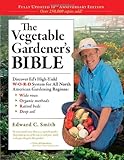
Ed Smith's W-O-R-D system has helped countless gardeners grow an abundance of vegetables and herbs. And those tomatoes and zucchini and basil and cucumbers have nourished countless families, neighbors, and friends with delicious, fresh produce. The Vegetable Gardener's Bible is essential reading for locavores in every corner of North America!
EVERYTHING YOU LOVED about the first edition of The Vegetable Gardener's Bible is still here: friendly, accessible language; full-color photography; comprehensive vegetable specific information in the A-to-Z section; ahead-of-its-time commitment to organic methods; and much more.
Now, Ed Smith is back with a 10th Anniversary Edition for the next generation of vegetable gardeners. New to this edition is coverage of 15 additional vegetables, including an expanded section on salad greens and more European and Asian vegetables. Readers will also find growing information on more fruits and herbs, new cultivar photographs in many vegetable entries, and a much-requested section on extending the season into the winter months. No matter how cold the climate, growers can bring herbs indoors and keep hardy greens alive in cold frames or hoop houses.
The impulse to grow vegetables is even stronger in 2009 than it was in 2000, when Storey published The Vegetable Gardener’s Bible. The financial and environmental costs of fossil fuels raise urgent questions: How far should we be shipping food? What are the health costs of petroleum-based pesticides and herbicides? Do we have to rely on megafarms that use gasoline-powered machinery to grow and harvest crops? With every difficult question, more people think, "Maybe I should grow a few vegetables of my own." This book will continue to answer all their vegetable gardening questions.
Praise for the First Edition:
"In every small town, there is a vegetable garden that people go out of the way to walk past. Smith is the guy who grew that garden." — Verlyn Klinkenborg, The New York Times Book Review
"An abundance of photographs . . . visually bolster the techniques described, while frequent subheads, sidebars, and information-packed photo captions make the layout user-friendly . . . [Smith's] book is thorough and infused with practical wisdom and a dry Vermont humor that should endear him to readers." — Publisher’s Weekly
"Smith . . . clearly explains everything novice and experienced gardeners need to know to grow vegetables and herbs. . . . " — Library Journal
"this book will answer all your questions as well as put you on the path to an abundant harvest. As a bonus, anecdotes and stories make this informative book fun to read." - New York Newsday
Ed's system is based on W-O-R-D: Wide rows, Organic methods, Raised beds, Deep soil. With deep, raised beds, vegetable roots have more room to grow and expand. In traditional narrow-row beds, over half the soil is compacted into walkways while a garden with wide, deep, raised beds, plants get to use most of the soil. In Ed's plan, growing space gets about three-quarters of the garden plot and only about a quarter is used for the walkway. Ed teaches you how to create raised beds both in a larger garden or in separate planked beds. One of the most important--and most often overlooked--aspects of successful vegetable gardening is crop rotation. Leaving a crop in the same place for years can deplete nutrients in that area and makes the crop more likely to be attacked by insects. Rotate at least every two years and your vegetables will be healthier and bug-free. There's also a good section on insect and blight control.
Before choosing what to grow, go through the last third of the book, where Ed takes a look at the individual growing, harvesting, and best varieties of a large number of both common and more exotic vegetables and herbs. Whether you are a putterer or a serious gardener, The Vegetable Gardener's Bible is an excellent resource to have handy. --Dana Van Nest
List Price: $ 24.95
Price: $ 13.75
